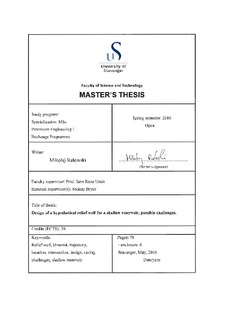| dc.contributor.author | Ralowski, Mikolaj | |
| dc.date.accessioned | 2016-09-21T12:36:56Z | |
| dc.date.available | 2016-09-21T12:36:56Z | |
| dc.date.issued | 2016-05-09 | |
| dc.identifier.uri | http://hdl.handle.net/11250/2409333 | |
| dc.description | Master's thesis in Petroleum engineering. | nb_NO |
| dc.description.abstract | Blowouts are one of the biggest threats during exploration and production of oil and gas. Losing
control of a well can lead to severe consequences both economically, environmentally and put the
working crew in danger. There are several blowout contingency methods which allow to regain control
of the well. Last resort method is to drill one or more relief wells, intersect with the blowing well and
perform a dynamic kill procedure. While relief well drilling and killing a blowing well through it is a
quite well-developed concept, there are some scenarios that require a different approach.
Such scenario would be when the reservoir lays very shallow below the seabed. In that case, regardless
whether it is an appraisal well or producer that gets the blowout, it cannot be killed through a relief
well of usual S-shaped trajectory because the depth is too small to drill such well. Such situation
requires a novel relief well design approach and needs to be addressed.
In this Thesis, a real-life shallow reservoir scenario located on a Barents Sea has been presented and
carefully evaluated. For this scenario, 2 relief well surface locations have been chosen and a novel, Ushaped
relief well trajectory has been proposed. The trajectory has been calculated and the entire
situation has been presented in modelling software such as 3Ddrill and Landmark COMPASS. Later,
casing design for the relief well has been proposed based on already existing concept of a horizontal
well designed for this particular location.
Possible challenges associated with such relief well trajectory design have been presented and
discussed. The U-shaped relief well will suffer from several obstacles that would need to be overcome,
such as difficulties in cuttings transport or reduced Weight on Bit due to well friction and high well
inclination. As the process of localizing, tracking and intersection will differ strongly from the typical
approach in S-shaped relief wells, potential challenges will also may occur on that stage. For some of
those difficulties, potential solutions have been proposed and discussed. Relief well should be drilled
with Rotary Steerable System. Process of localizing and tracking could be performed with the use of
such technologies as Casing Premagnetization and Surface Seismic While Drilling. To design the
intersection, the approach utilized on Montara Blowout can be used. The blowing well can be
bypassed, its casing can then be located and the intersection could happen in following approaches
from sidetracks.
The design proposed in this Thesis is only a conceptand to prove its feasibility further development is
needed. Recommendations for future work include modelling of the drilling process, for example
torque & drag calculations or drilling parameters calculations. Also, if the geological scenario is
available, detailed casing design could be calculated and proposed. Dynamic kill procedure modelling
with such tools as OLGA Software would be also a very interesting topic to cover. | nb_NO |
| dc.description.sponsorship | PGNiG Upstream International AS | nb_NO |
| dc.language.iso | eng | nb_NO |
| dc.publisher | University of Stavanger, Norway | nb_NO |
| dc.relation.ispartofseries | Masteroppgave/UIS-TN-IPT/2016; | |
| dc.rights | Navngivelse 3.0 Norge | * |
| dc.rights.uri | http://creativecommons.org/licenses/by/3.0/no/ | * |
| dc.subject | relief well | nb_NO |
| dc.subject | blowout | nb_NO |
| dc.subject | petroleum engineering | nb_NO |
| dc.subject | shallow reservoir | nb_NO |
| dc.subject | petroleumsteknologi | nb_NO |
| dc.title | Design of a hypothetical relief well for a shallow reservoir, possible challenges. | nb_NO |
| dc.type | Master thesis | nb_NO |
| dc.subject.nsi | VDP::Technology: 500::Rock and petroleum disciplines: 510::Petroleum engineering: 512 | nb_NO |
| dc.source.pagenumber | 84 | nb_NO |

